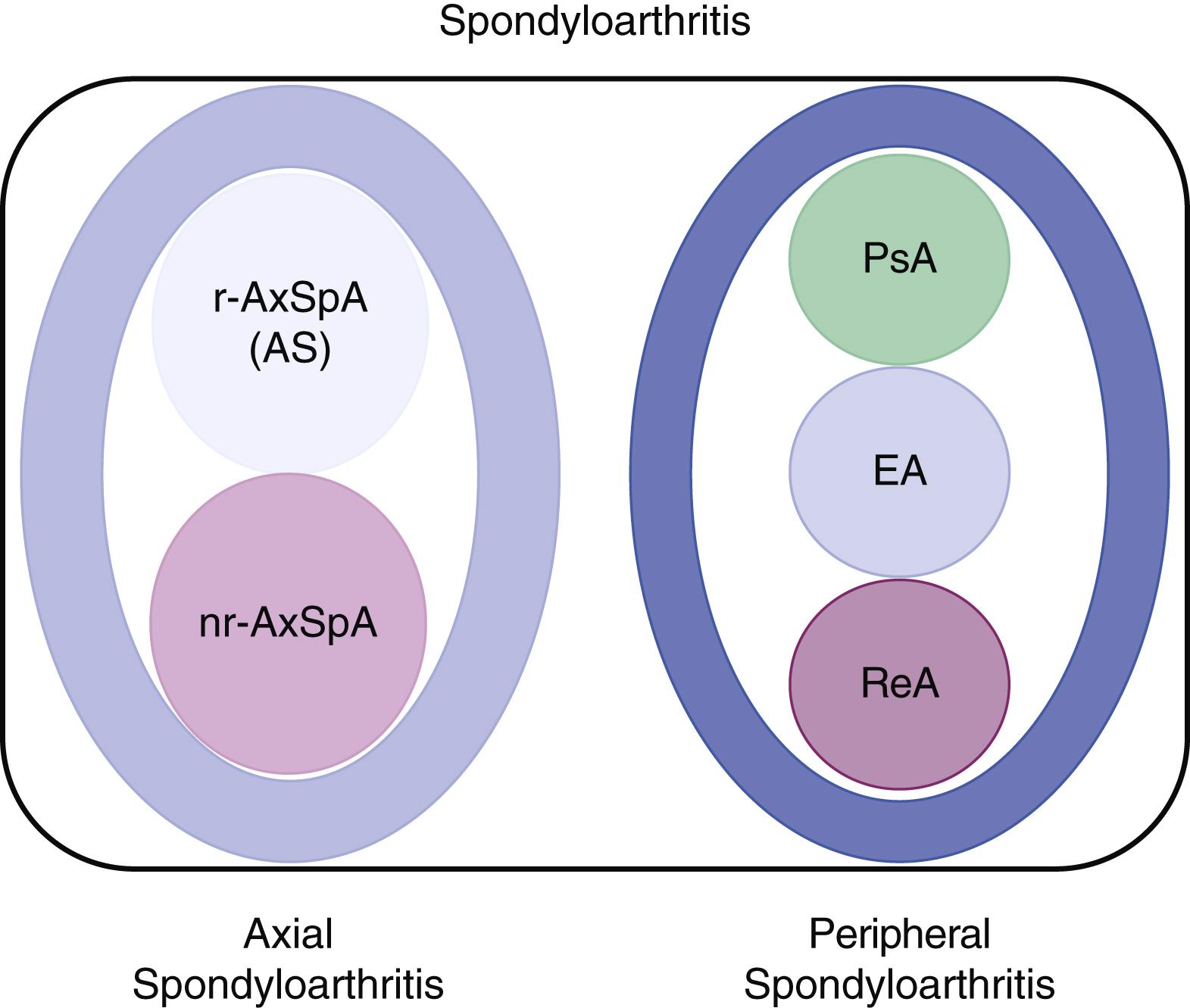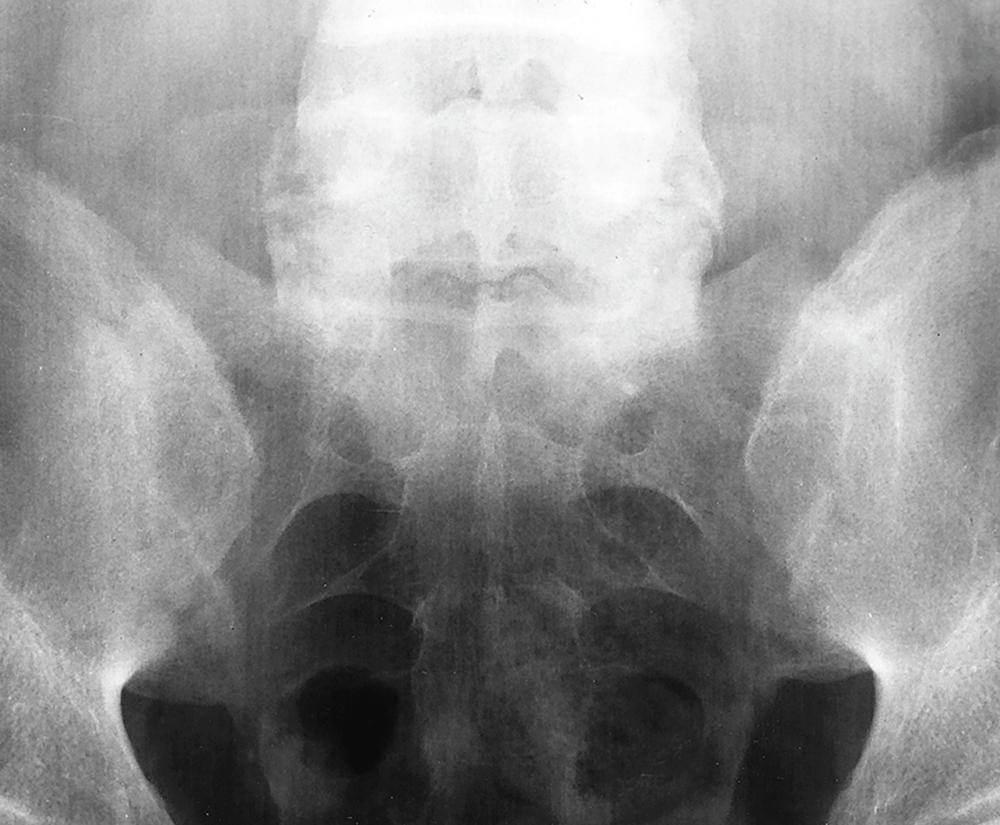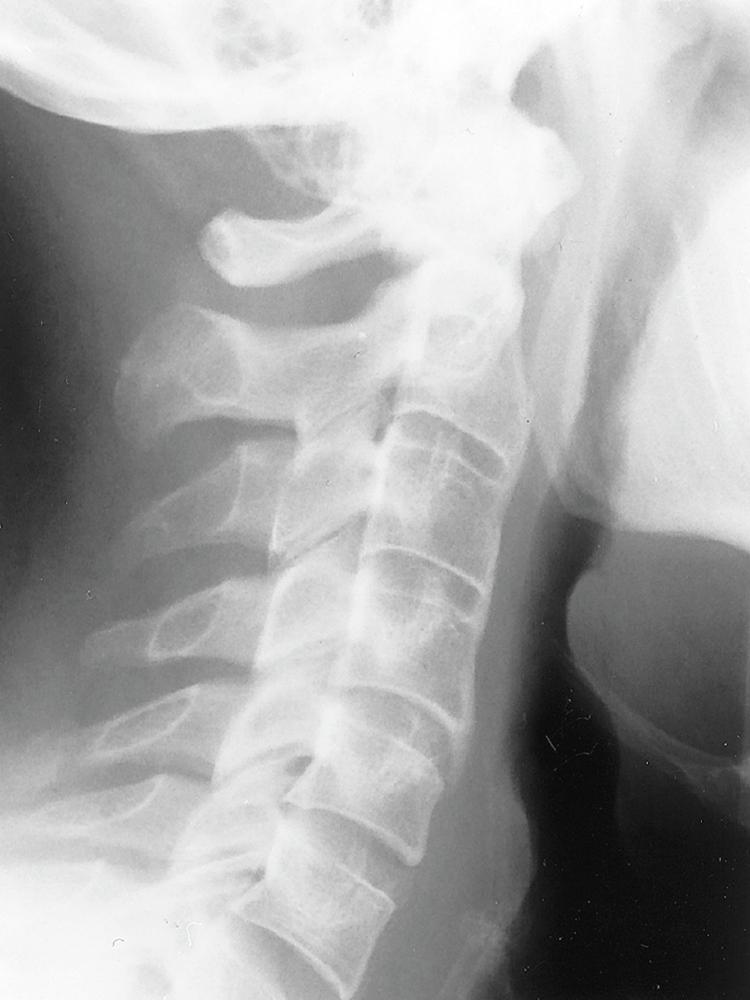Physical Address
304 North Cardinal St.
Dorchester Center, MA 02124
Spondyloarthritis encompasses a group of clinical syndromes that are linked in terms of disease manifestations and genetic susceptibility. The clinical subsets most commonly recognized are ankylosing spondylitis, psoriatic arthritis, reactive arthritis, and enteropathic arthritis ( Fig. 244-1 ). Broadly, spondyloarthritis is grouped into two subsets based on the location of predominantly affected joints: axial spondyloarthritis (dominated by back symptoms) and peripheral spondyloarthritis (dominated by peripheral joint symptoms). The Assessment of SpondyloArthritis international Society further classified axial spondyloarthritis into radiographic axial spondyloarthritis (commonly referred to as ankylosing spondylitis), in which structural damage is visible on plain radiographs of the sacroiliac joint, and nonradiographic axial spondyloarthritis, in which no structural damage to the sacroiliac joints is seen on plain radiographs.

Family studies note excessive clustering of the same disease entity among family members as well as common features among the distinct subsets. The impression from such studies is a shared common path of immunogenetic susceptibility, with further genetic and environmental influences that lead to characteristic clinical subsets. For example, enteropathic arthritis may occur in one family, whereas psoriatic arthritis may occur in another family.
In genomic studies of families with spondyloarthritis, particularly ankylosing spondylitis and psoriatic arthritis, the strongest association is with HLA-B27. About 90% of patients with ankylosing spondylitis are B27-positive, so to a certain extent it may be necessary but not sufficient for the disease. Magnetic resonance imaging (MRI) studies in asymptomatic B27-positive individuals indicate a much higher prevalence of sacroiliitis than previously recognized. Spondyloarthritis may be as common as rheumatoid arthritis.
The major histocompatibility complex (MHC), on the short arm of chromosome 6 in humans, is one of the most polymorphic regions of the human genome. This is particularly so for the B locus, which constitutes part of the class 1 MHC genes in this complex. More than 200 different alleles have been detected at this locus, of which B27 is just one. As with all HLA alleles, there is codominant expression of B locus genes, such that most individuals who are B27-positive are heterozygous for the B locus. There appears to be little clinical or prognostic significance associated with the less common homozygous B27 state.
It is clear that HLA is strongly associated with spondyloarthritis, yet the prevalence of HLA-B27 varies widely in different racial and ethnic clusters around the world. It is virtually absent in aboriginal populations in Australia, occurs in 1% of the population in Japan, in 7% in northern European countries and in North American White populations, and in 50% of some of the native tribes in western Canada.
Of the more than 30 subtypes of B27, HLA-B2705 is regarded as the primordial subtype, with variability developing over time on the basis of alterations in genomic DNA. Some subtypes, notably B2706 and B2709, do not seem to confer increased susceptibility to the development of ankylosing spondylitis. This observation has led to a search for arthritogenic peptides that are presented by the disease-associated subtypes such as B2705 and B2704, but not by the non–disease-associated subtypes. To date, no simple peptide-susceptibility relationship has been demonstrated.
Polymorphisms in the endoplasmic reticulum aminopeptidase-1 ( ERAP1 ) gene on chromosome 5 are the second strongest genetic risk factor for ankylosing spondylitis after HLA-B27, and the association with ankylosing spondylitis and ERAP1 is restricted to patients with HLA-B27+ ankylosing spondylitis, thereby suggesting a gene–gene interaction. ERAP plays a key role in trimming peptides in the endoplasmic reticulum before loading these peptide complexes onto a nascent class I MHC molecule. This finding continues to attribute a central role to MHC class I peptide presentation in the pathogenesis of ankylosing spondylitis.
Additional genetic markers outside the MHC region include the IL-23R gene on chromosome 1, which is associated with ankylosing spondylitis, inflammatory bowel disease, and psoriasis. Overall, more than 100 genes confer susceptibility to ankylosing spondylitis, but with the notable exception of HLA-B27, the odds ratio for each is modest.
At the level of joint histopathology, sites of chronic inflammation in rheumatoid arthritis are associated with erosions, but in spondyloarthritis, such sites are associated with new bone formation. This distinction suggests a fundamental difference in the cytokine profile in the microenvironment of the joint. Synovial histopathology in spondyloarthritis is characterized by abundant neutrophils, macrophages, and hypervascularity, whereas in rheumatoid arthritis, the prominent features are lymphoid aggregates, dendritic cells, lining cell hyperplasia, and citrullinated proteins. These differences suggest that spondyloarthritis reflects a fundamental alteration in innate immunity, whereas rheumatoid arthritis reflects dysregulation of adaptive immunity ( Chapter 35 ).
Common features among the clinical subsets of spondyloarthritis both link them with and distinguish them from rheumatoid arthritis ( Chapter 243 ), which is the other major cause of chronic polyarthritis. Spondyloarthritis has a strong predilection for the spine, in particular the sacroiliac joints, with a tendency for new bone formation at sites of chronic inflammation to cause joint ankylosis. When peripheral arthritis occurs, it is commonly in the lower extremity and asymmetrical. There is a predilection for involvement at sites where tendon inserts into bone (entheses), so enthesitis is one of the most specific clinical manifestations of spondyloarthritis.
A predilection for ocular inflammation, particularly acute anterior uveitis, is a common feature of spondyloarthritis. Uveitis may occur in the same susceptible population of patients even in the absence of joint involvement. Finally, all spondyloarthritis subsets have an association with the class I HLA allele B27, with the strength of the association varying somewhat among them.
Classification criteria ( Table 244-1) emphasize the common clinical features—namely, inflammatory spinal pain or asymmetrical lower extremity synovitis. To fulfill the criteria for axial spondyloarthritis, patients must have chronic back pain for at least 3 months and starting prior to age 45 years. Sacroiliitis confirmed by imaging is an important criterion, and it is referred to as radiographic axial spondyloarthritis when structural damage can be detected by plain radiographs. When active inflammation is detected only by MRI, it is referred to as non-radiographic axial spondyloarthritis. Nonradiographic axial spondyloarthritis can also be defined by the presence of the HLA-B27 allele and two additional features of spondyloarthritis.
OR |
OTHER CRITERIA
|
Several distinct features differentiate spondyloarthritis from rheumatoid arthritis, the other main contributor to the differential diagnosis of chronic polyarthritis ( Table 244-2 ). Imaging is often critical for making a diagnosis of axial spondyloarthritis or peripheral spondyloarthritis. , Useful clinical features include sex predilection, HLA association, pattern of joint involvement, and presence of rheumatoid factor, which becomes the serologic distinction between seropositive rheumatoid arthritis and seronegative spondyloarthritis.
| FEATURE | RHEUMATOID ARTHRITIS | ANKYLOSING SPONDYLITIS | ENTEROPATHIC ARTHRITIS | PSORIATIC ARTHRITIS | REACTIVE ARTHRITIS |
|---|---|---|---|---|---|
| Male-female ratio | 1 : 3 | 3 : 1 | 1 : 1 | 1 : 1 | 10 : 1 |
| HLA association | DR4 | B27 | B27 (axial) | B27 (axial) | B27 |
| Joint pattern | Symmetrical, peripheral | Axial | Axial and peripheral | Axial and asymmetrical, peripheral | Axial and asymmetrical, peripheral |
| Sacroiliac | Absent | Symmetrical | Symmetrical | Asymmetrical | Asymmetrical |
| Syndesmophyte | Absent | Smooth, marginal | Smooth, marginal | Coarse, nonmarginal | Coarse, nonmarginal |
| Eye | Scleritis | Iritis | +/− | +/- | Iritis and conjunctivitis |
| Skin | Vasculitis | Rare | Erythema nodosum | Psoriasis | Keratoderma |
| Rheumatoid factor | >80% | Rare | Rare | Rare | Rare |
Ankylosing spondylitis, now referred to as radiographic axial spondyloarthritis, is the most common inflammatory disorder of the axial skeleton. Ankylosing spondylitis occurs in about 0.2% of the general population, in about 2% of the B27-positive population, and in about 20% of B27-positive individuals with an affected family member. The male-to-female ratio historically has ranged from 2.5 : 1 to 5 : 1, but recent epidemiologic studies suggest a lower ratio.
Molecular mimicry has been hypothesized in the pathogenesis of ankylosing spondylitis because of the degree of sequence homology between B27 and several candidate gram-negative enteric bacteria, but the significance of such homology remains unresolved. B27 is distinctive in its propensity to misfold in the endoplasmic reticulum, where it may induce a pro-inflammatory cascade called the unfolded protein response. Furthermore, B27 may have a distinct tendency to form heavy-chain homodimers at the cell surface.
B27 transgenic rats spontaneously develop pathology that is strikingly similar to human spondyloarthritis, so B27 itself may be the critical genetic factor in disease pathogenesis. These animals demonstrate pathology similar to that of Crohn disease in the gastrointestinal tract. Of interest, if such animals are raised in a germ-free environment, there is a marked reduction in joint disease, thereby implying a dynamic interrelationship between microbial triggers and background host genes.
Ankylosing spondylitis typically begins in young adulthood, but symptoms may arise in adolescence or earlier. Up to 15% of children with juvenile idiopathic arthritis are classified as having juvenile ankylosing spondylitis. During the adolescent years there is an increasing prevalence of radiographic sacroiliitis, with a significant proportion of patients manifesting this feature by the end of the teenage years. At the other end of the age spectrum, a small number of patients with late-onset ankylosing spondylitis may have sacroiliitis and oligoarthritis. The axial involvement and asymmetrical lower extremity involvement may serve to differentiate such patients from patients with late-onset rheumatoid arthritis, although there may be overlapping clinical features.
The classic manifestation of ankylosing spondylitis is the onset of low back pain that persists for more than 3 months, is accompanied by early-morning stiffness, and is typically improved by exercise but not by rest ( Table 244-3 ). Some experts include a response to NSAID therapy as an additional feature that differentiates ankylosing spondylitis from mechanical low back pain. Back pain that awakens the patient from sleep is often a clue to inflammatory back pain that may have been misdiagnosed as the pain of degenerative disc disease ( Chapter 369 ), which is a much more common cause of low back pain in the population at large.
| CLINICAL CRITERIA |
| Low back pain and stiffness for >3 mo that improve with exercise but are not relieved by rest Limitation of motion of the lumbar spine in both sagittal and frontal planes Limitation of chest expansion |
| RADIOLOGIC CRITERIA |
| Sacroiliitis: grade ≥2 bilateral or grade 3 or 4 unilateral |
| GRADING |
| Definite AS if the radiologic criterion is associated with at least one clinical variable Probable AS if:
|
The pain typically occurs in the region of the sacroiliac joints, with or without slight radiation to the buttock area. Midthoracic pain and cervical pain, particularly at night, are less common but strongly suggest inflammatory back pain when they occur. Fatigue is also a suggestive symptom and is often a major concern for the typical young male patient who has a high functional target in terms of sports and recreation. If the inflammation is inadequately controlled, stiffness may persist most of the day and progress to loss of mobility and flexibility.
Peripheral oligoarthritis is seen in up to 30% of patients with ankylosing spondylitis. Typically, it is an asymmetrical oligoarthritis with a predilection for the lower extremities. It is important to ask about concurrent or previous tendinitis (e.g., Achilles tendinitis) or heel pain (e.g., plantar fasciitis), because either may reflect an enthesitis ( Chapter 242 ) that is part of the clinical picture. Involvement of the hip can occur at any point in the course of ankylosing spondylitis and can progress to joint destruction. On standing and walking, a hip flexion contracture may contribute to an increasing stoop that might otherwise be attributed to spinal involvement in the disease.
Ocular involvement may occur in up to 40% of ankylosing spondylitis patients, most typically acute anterior uveitis (iritis). The uveitis often manifests as a slight impairment in visual acuity, with accompanying photophobia and eye pain. Typically, it is unilateral and recurrent. Inflammatory bowel disease ( Chapter 127 ) and psoriasis ( Chapter 405 ) occur in approximately 10% of patients with ankylosing spondylitis. Less common manifestations include aortic insufficiency ( Chapter 60 ), cardiac conduction defects ( Chapter 51 ), and apical pulmonary fibrosis ( Chapter 80 ).
Physical examination of the spine characteristically indicates restricted movement, which in the early stages may partly reflect paraspinal muscle spasm but later in the course reflects ankylosis of the zygapophyseal joints and syndesmophyte bridging of the vertebral bodies. Changes in cervical mobility can be measured as the occiput-to-wall distance, with the patient’s heels against the wall as the patient attempts to touch the back of the head to the wall. Thoracic involvement is measured in chest expansion, with the chest circumference at maximal inspiration being more than 5 cm greater than the circumference at maximal expiration. In the lumbar spine, forward flexion is restricted and can be monitored by the Schober test. This test is used to measure mobility in the lower part of the back: with the patient standing upright, a 10-cm span is marked from the fifth lumbar vertebra upward. On maximal forward flexion, the distance between the marks is remeasured. With normal spinal mobility, the flexed distance should register as 15 cm or an increment of 5 cm. Restricted spinal mobility early in the course of the disease may best be detected by lateral spinal flexion, measured as the difference in the finger-to-floor distance when standing erect compared with maximal bending to the side. Inflammation in the sacroiliac joint may be reflected by joint line tenderness to direct pressure or by the FABERE test (for Flexion, ABduction, External Rotation, and Extension) or Gaenslen maneuver. In the former, the patient lies supine while the examiner flexes and externally rotates the hip. In the latter, the examiner extends the hip by letting the leg dangle off the side of the examining table. In both cases, stress is placed on the sacroiliac joint and may reproduce the back pain if it derives from this site.
Laboratory tests in the evaluation of inflammatory back pain are relatively nonspecific. The ESR and CRP are typically elevated, but normal levels do not exclude inflammatory back pain, and the degree of elevation is typically less than would be seen in active rheumatoid arthritis. Anemia of chronic disease may be observed if the condition is long-standing. HLA-B27 is rarely the definitive factor for diagnosis, but the test has reasonably high sensitivity and specificity in the setting of characteristic back symptoms.
Radiographic assessment is important to confirm the diagnosis, but no radiographic changes may be seen in the sacroiliac joints early in the course of disease. If the clinician has a high index of suspicion, MRI may improve the sensitivity of the plain radiograph because inflammatory changes on MRI predate radiographic changes. A routine anteroposterior pelvic radiograph is generally the standard diagnostic radiograph, and the classic findings are bilateral changes in the sacroiliac joints ( Fig. 244-2 ). Abnormalities include erosions in the joint line, pseudowidening, subchondral sclerosis, and, finally, ankylosis that reflects complete bony replacement of the sacroiliac joints.

Radiographs of the spine may reveal squaring of the vertebral bodies (loss of the normal anterior concavity of the lumbar vertebra) and “shiny corners” (subchondral sclerosis at the upper edge of the vertebral body), both of which are manifestations of enthesitis. Syndesmophytes, which represent marginal bridging of the vertebrae ( Figs. 244-3 and 244-4 ), eventually develop and make the diagnosis clear. Because ankylosis of the apophyseal joints may occur without syndesmophyte formation, it is important to assess the posterior joints on lateral views of the lumbosacral spine, as well as the anterior margin of the vertebrae. Eventually, the changes may result in a “bamboo spine,” so called because the bridging syndesmophytes can mimic the appearance of bamboo.


The differential diagnosis of ankylosing spondylitis includes osteitis condensans ilii; diffuse idiopathic skeletal hyperostosis (DISH; Chapter 238 ); the syndrome of synovitis, acne, pustulosis, hyperostosis, and osteomyelitis (SAPHO); and some induced hyperostotic states (e.g., vitamin A intoxication, fluorosis). New bone formation occurs in degenerative disc disease, but the bulky horizontal appearance of osteophytes is usually easily distinguished from that of syndesmophytes, and narrowing of the disc space is not a feature of ankylosing spondylitis. Osteoarthritis of the sacroiliac joint is more common than previously appreciated.
Reactive arthritis is an aseptic arthritis that occurs subsequent to an extra-articular infection, most typically of the gastrointestinal or genitourinary tract. Typically, the onset of arthritis occurs 1 to 3 weeks after the gastrointestinal or genitourinary infection, but the temporal details are often difficult to define precisely.
In the gastrointestinal tract, the key pathogens are Salmonella typhimurium , Yersinia enterocolitica , Shigella flexneri , and Campylobacter jejuni . In the genitourinary tract, Chlamydia trachomatis is the most common offender.
The true incidence and prevalence of reactive arthritis are not well defined. In epidemics involving Salmonella ( Chapter 284 ) or Yersinia ( Chapter 288 ), reactive arthritis develops in 2 to 7% of infected individuals but in as many as 20% of B27-positive infected individuals. In such epidemic studies, B27 confers risk not only for the onset of arthritis but also for axial involvement and chronicity. Genetic variants in toll-like receptor 2 (TLR-2) implicate host innate immunity as central in reactive arthritis.
Become a Clinical Tree membership for Full access and enjoy Unlimited articles
If you are a member. Log in here